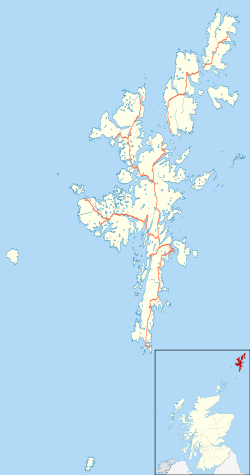| Skaw | |
|---|---|
 The beach of Skaw | |
Location within Shetland | |
| OS grid reference | HP657163 |
| • Edinburgh | 348 mi (560 km) |
| • London | 644 mi (1,036 km) |
| Civil parish | |
| Council area | |
| Lieutenancy area | |
| Country | Scotland |
| Sovereign state | United Kingdom |
| Post town | SHETLAND |
| Postcode district | ZE2 |
| Dialling code | 01806 |
| Police | Scotland |
| Fire | Scottish |
| Ambulance | Scottish |
| UK Parliament | |
| Scottish Parliament | |
Skaw is a settlement in the Scottish archipelago of Shetland, located on the island of Unst. It is located north of Haroldswick on a peninsula in the northeast corner of the island, and is the most northerly settlement in the United Kingdom. [1] It is currently inhabited by a single inhabitant whose business is sheep farming.

